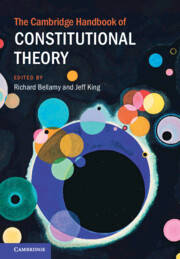Book contents
- The Cambridge Handbook of Constitutional Theory
- The Cambridge Handbook of Constitutional Theory
- Copyright page
- Contents
- Figures
- Contributors
- Frontispiece
- Preface and Acknowledgements
- 1 Introduction
- Part I Values
- 2 Human Dignity
- 3 Rights
- 4 Equality
- 5 Liberty
- 6 Well-Being
- 7 Self-Government
- 8 Justice
- 9 Recognition
- Part II Modalities
- Part III Institutions
- Part IV Challenges for Constitutional Democracy
- Bibliography
- Index
- References
5 - Liberty
from Part I - Values
Published online by Cambridge University Press: 27 March 2025
- The Cambridge Handbook of Constitutional Theory
- The Cambridge Handbook of Constitutional Theory
- Copyright page
- Contents
- Figures
- Contributors
- Frontispiece
- Preface and Acknowledgements
- 1 Introduction
- Part I Values
- 2 Human Dignity
- 3 Rights
- 4 Equality
- 5 Liberty
- 6 Well-Being
- 7 Self-Government
- 8 Justice
- 9 Recognition
- Part II Modalities
- Part III Institutions
- Part IV Challenges for Constitutional Democracy
- Bibliography
- Index
- References
Summary
Freedom in a choice does not just requires the absence of interference by another, whether with a preferred option or with any option; it requires the absence of domination: the absence of vulnerability to a power of interference on the part of another. Law and only law can guard citizens equally against the domination of others by identifying a common set of basic liberties and by providing intuitively adequate resourcing and protection against others to enable people to exercise those choices. But the state that imposes law will itself dominate all or some of its citizens if it is not subjected to a system of intuitively adequate, democratic control over its imposition of law. Such a system should enable people to shape the framework of government, to impose operational checks, constitutional and contestatory, on officials in government, and to appoint or oversee the appointment of such authorities.
- Type
- Chapter
- Information
- The Cambridge Handbook of Constitutional Theory , pp. 71 - 87Publisher: Cambridge University PressPrint publication year: 2025

